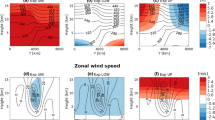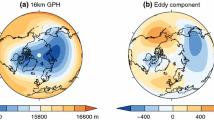Summary
The effects of surface temperature anomalies (STAs) upon frontal cyclones are investigated with a nonlinear model. The model used is a modified version of the NCAR Community Climate Model (CCM 1). The experiments are run with hemispheric domain and R 30 (rhomboidal) truncation. The present study isolates the effects of sensible heating. Topography and latent heating are excluded from this model. The initial data are created from a solution (normal mode) to the linear eigenvalue problem. Six experiments use various locations and intensities for dipole-shaped STA; one control case is run without STA. The intensity is either ±5 or ±10°K and the anomalies ae located at 40°N, 50°N, or 35°N. The jet is centered at 40°N. All cases are run for 20 days. Nonlinear, time-dependent, growth rate and phase frequency are derived and compared to the linear (eigenvalue) amounts.
The resulting waves grow primarily by baroclinic instability. Perturbation fields at higher levels grow faster before they mature (“occlude”) and decay faster afterward, than do lower level fields. The baroclinic conversion of energy lessens as the perturbations mature. The principal hypothesis tested is that: the STA alters the static stability which in turn modulates the baroclinic instability. Over warm anomalies the static stability should be reduced, enhancing baroclinic instability. Over cold anomalies the opposite may happen. The nonlinear simulations confirm this hypothesis in part. In the present study, the intensity of the warm anomaly produces greater growth rate during and after the storm's mature state. Larger STA intensity increases the maximum amplitude of the perturbation in a roughly linear fashion. However, the STA effects are nonlinear after maximum amplitude is reached: during decay, the difference in amplitude between the control case and the 10°K STA case is more than twice the difference between the control and 5°K case. In contrast, little deviation from the control case is found for perturbations over the cold anomaly, indicating a nonlinear link between STA and wave growth. The latitudinal variation used of the surface temperature anomaly centers had no significant influence on the baroclinic growth. Secondary growths of storms after 10 days are more commonly seen in cases with STA.
Similar content being viewed by others
References
Baines, P. G., Frederiksen, J. S. 1978: Baroclinic instability on a sphere in two-layer models.Quart. J. Roy. Met. Soc.,104, 45–68.
Bath, M. B., Dias, M. A., Williamson, D. L., Williamson, G. S., Wolski, R. J., 1987 a: User's Guide to NCAR CCM1. NCAR Technical Note, NCAR/TN-286+1A, 173 pp.
Bath, M. B., Dias, M. A., Williamson, D. L., Williamson, G. S., Wolski, R. J., 1987 b: Documentation of NCAR CCM 1 program modules. NCAR Technical Note, NCAR/TN-287+IA, 307 pp.
Charney, J. G., 1947: The dynamics of long waves in a baroclinic westerly current.J. Meteor.,4, 135–162.
Chervin, R. M., 1980: Response of the NCAR general circulation model to prescribed changes in ocean surface temperature. Part II: Midlatitude and subtropical changes.J. Atmos. Sci.,37, 308–332.
Dias, M. A., 1987: Introduction to the CCM Modular Processor (Version PROC(02)). NCAR Technical Note, NCAR/TN-289+IA, 59 pp.
Eady, E. T. 1949. Long waves and cyclone waves.Tellus 1, 33–52.
Errico, R. M., 1987: A Description of Software for Determination of Normal Modes of the NCAR Community Climate Model. NCAR Technical Note, NCAR/TN-277+STR, 88pp.
Frederiksen, J. S., 1981: Disturbances and eddy fluxes in Southern hemisphere flows: Linear theory.J. Atmos. Sci.,38, 673–689.
Frederiksen, J. S., Puri, K., 1985: Nonlinear instability and error growth in northern hemisphere three-dimensional flows: Cyclogenesis, onset-of-blocking and mature anomalies.J. Atmos. Sci.,42, 1374–1397.
Gall, R., 1976a: Structural changes of growing baroclinic waves.J. Atmos. Sci.,33, 374–390.
Gall, R., 1976b: A comparison of linear baroclinic instability theory with the eddy statistics of a general circulation model.J. Atmos. Sci.,33, 349–373.
Grotjahn, R., 1979: Cyclone development along weak thermal fronts.J. Atmos. Sci.,36, 2049–2074.
Grotjahn, R., 1987: Three dimensional linear instability on a sphere: Resolution experiments with a model using vertical orthogonal basis functions.J. Atmos. Sci.,44, 3734–3752.
Grotjahn, R., Wang, C.-H., 1989: On the source of air modified by ocean surface fluxes to enhance frontal cyclone development.Ocean-Air Interaction,1, 257–288.
Hoskins, B. J., McIntyre, M. E., Robertson, A. W., 1985: On the use and significance of isentropic potential vorticity maps.Quart. J. Roy. Meteor. Soc.,111, 877–946.
Huang, J. C. K., 1978: Response of the NCAR general circulation model to North Pacific sea-surface temperature anomalies.J. Atmos. Sci.,35, 1164–1179.
Kutzbach, J. E., Chervin, R. M., Houghton, D. D., 1977: Response of the NCAR General Circulation Model to prescribed changes in ocean surface temperature. Part I: Mid-latitude changes.J. Atmos. Sci.,34, 1200–1213.
Machenauer, B., 1977: On the dynamics of gravity oscillations in a shallow water model, with application to normal mode initialization.Contrib. Atmos. Phys.,50, 253–271.
Phillips, T. J., 1982: On the interaction of surface heating anomalies with zonally symmetric and asymmetric atmospheric flow.J. Atmos. Sci.,39, 1953–1971.
Rasch, P. J., 1985: Developmens in normal mode initialization, Part II: A new method and its comparison with currently used schemes.Mon. Wea. Rev.,113, 1753–1770.
Staley, D. O., Gall, R. L., 1977: On the wavelength of maximum baroclinic instability.J. Atmos. Sci.,34, 1679–1688.
Simmons, A. J., Hoskins, B. J., 1976: Baroclinic instability on the sphere: Normal modes of the primitive and quasigeostrophic equations.J. Atmos. Sci.,33, 1454–1477.
Simmons, A. J., Hoskins, B. J., 1978: The life cycles of some nonlinear baroclinic waves.J. Atmos. Sci.,35, 414–432.
Williamson, D. L., Kiehl, J. T., Ramanathan, V., Dickinson, R. E., Hack, J. J., 1987. Description of NCAR Community Climate Model (CCM 1). NCAR Technical Note. NCAR/TN-285+STR, 112 pp.
Wolski, R. J., 1987: CCM Modular Processor User's Guide. NCAR Technical Note, NCAR/TN-290+IA.
Author information
Authors and Affiliations
Rights and permissions
About this article
Cite this article
Grotjahn, R., Lai, SS. Nonlinear impacts upon frontal cyclones from dipole surface temperature anomalies. Meteorl. Atmos. Phys. 45, 159–180 (1991). https://doi.org/10.1007/BF01029652
Received:
Revised:
Issue Date:
DOI: https://doi.org/10.1007/BF01029652




